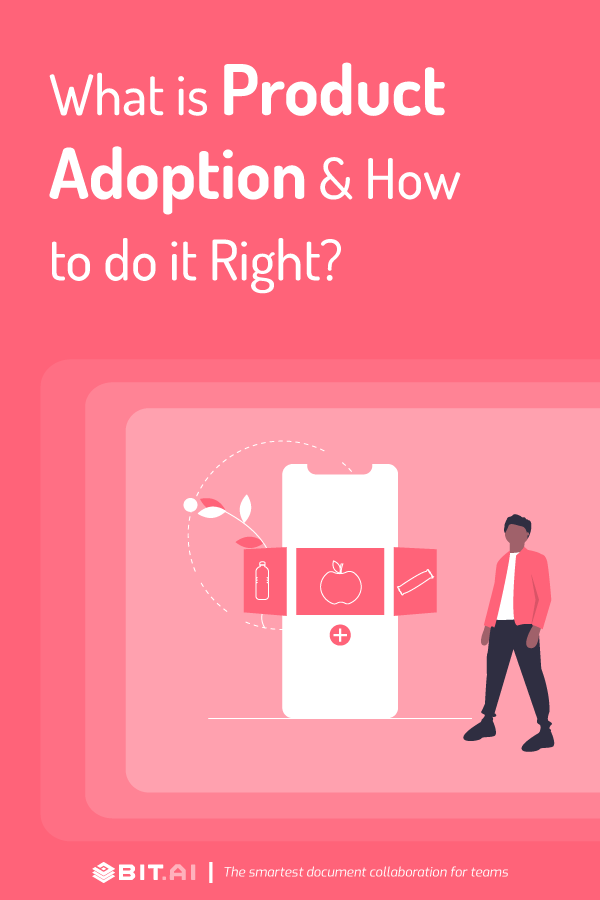Did you know that acquiring a new customer can cost five times more than retaining an existing customer? Moreover, increasing customer retention by 5% can increase profits from 25-95%!
The key to customer retention however lies is product adoption. When a customer finds immense value in your product, they are likely going to stick with it. However, getting them to use your product or service is an uphill battle. You know that your product is great and customers will love it once they start using it. But, helping your customers get over the learning curve is tough.
Your potential customers are reasonably more comfortable staying where they are rather than taking a chance on your new product. The comfort of the known is far greater than the excitement of the unknown. However, all is not lost. There are many ways to convince your prospects to make the move and switch to your product, increasing product adoption.
But let’s not get ahead of ourselves just yet. Let us quickly understand what we mean by the term “product adoption” and why does it even matter. Read on…
What is Product Adoption? (Definition)
Product adoption is the process by which users become aware of a product, realize its value proposition, and begin using it. The product adoption process is broke down into five stages: awareness, interest, evaluation, trial, adoption- which we will talk about in detail in the next section.
Increased product adoption leads to customer success, improves customer retention rates, reduces churn, and leads to a more predictable revenue stream. When you have loyal customers who love using your product, there’s a higher chance of upselling/cross-selling them and directing your focus to expand your market footprint.
Often product adoption is linked to metrics like the number of sign-ups or DAU (daily active users). As much as these numbers are important, they don’t show the full picture. It’s tough to measure how well customers have incorporated your product in their lives and whether it is something they can’t do their jobs without.
Product adoption goes a level deeper, looking for fans of your product who not only love using your product but also provide a free word of mouth marketing for it as well!
Such product adoption occurs when the value of your product is so prominent that it outweighs the cost/effort required by the user to make a change. While its important to lure in early adopters and people who love change and new experiences, product adoption also caters to the needs of existing customers by continuously improving the product, adding the most asked features, and providing an amazing service experience.
Read more: Product-Market Fit: What is it & How to Achieve it?
Diffusion of Innovations Theory of Product Adoption
Every time a company launches a new product, some people get excited to try it out while others don’t seem to care. Whenever Apple launches a new iPhone, every year, thousands of people line-up outside Apple stores to be the first ones to get their hands on the new smartphone. Why?
Well, the answers to this phenomenon lie in a book published decades ago in 1962 called Diffusion of Innovations. The book was written by Everet Rogers, a professor of communication studies. Rogers talks about how there are four key factors that influence the spread of a new idea: the innovation itself, communication channels, time, and a social system and that this whole system relies heavily on humans.
In order for the new idea to self-sustain, it must be widely adopted.

The categories of adopters given by Rogers in his book are innovators, early adopters, early majority, late majority, and laggards. Rogers suggests that any society has these 5 different adopter groups based on how early they adapt to a new idea or innovation.
The Innovators (2.5%)
The innovators are the first group of people who try out your product. Though a small percentage, these people are very important for your product as these are the ones constantly checking new tech websites, looking at new commercials, and are obsessed with new innovations and ideas.
The Early Adopters (13.5%)
Another small group of forward-thinking people is early adopters. Similar to the innovators, early adopters, too, like engaging with new innovations and are often referred to as the trailblazers. While innovators don’t really care about reviews and jump straight in whenever a new product enters a market, the early adopters might wait for some time before giving in.
The Early Majority (34%)
Once you have got some sales from the innovators and the early adopters, your product is likely to pick momentum. The early majority now swoops in, waiting for the innovators and early adopters to try out the new innovation and give their reviews. The early majority only adopts a product once they are assured that it has tangible benefits and that it is the new status quo.
The Late Majority (34%)
By now, your product is widely adopted in the market and has got great reviews. However, there will still be some people who are a bit skeptical of your product. Only when are fully convinced about its benefits will they start using it. This group is more resistant to change and hence takes a long time before making the switch to new innovation.
Laggards (16%)
The last group is called Laggards. Such people are either highly unwilling to change, skeptics, or never heard of your product until after a few years of its launch. Laggards often have very little exposure to media, making them hard to reach with marketing campaigns
Rogers’ theory provides us with the blueprint of product adoption and shows us that if we want to promote our product for widespread adoption, we need to market each adopter group separately using different messages and communication (marketing) channels.
Read more: Product Development Process: Definition & Key Stages!
5 stages of the Product Adoption Process
Every individual, no matter which product adoption group he/she belongs to, goes through the following 5 stages, irrespective of the type of product involved.
1. Awareness or the Introduction Stage
The first stage of product adoption is called the awareness stage. Here, a prospect comes across your product to know more about it since he/she doesn’t have sufficient knowledge about it yet.
 It’s your job to educate customers about the problem your product or service solves and create brand awareness for your brand. Make sure they have a smooth onboarding experience, making a great first impression.
It’s your job to educate customers about the problem your product or service solves and create brand awareness for your brand. Make sure they have a smooth onboarding experience, making a great first impression.
2. Interest or the Information-gathering Stage
Once the prospect is made aware of your product and has an initial liking towards it, he/she tries to find out more info about it. Make sure you have a well-setup help center and customer care (or chatbot) to answer any questions a prospect might have about your product or service.
3. Evaluation or Consideration Stage
At this stage, a prospect mentally evaluates your product and compares it with other similar products he might have seen or tried. Making your messaging clear about who the product is for and how it is different from the alternatives can help the prospect make a decision in favor of your product.
4. Trial or Sampling Stage
The prospect is now convinced about your value proposition is willing to give your product a try for a limited period of time or in a confined capacity. Deploying free trials and/or schemes like a money-back guarantee can nudge the prospect is trying out your product without thinking about it too much.
5. Adoption- Buy or not Buy Stage
In the last stage, the prospect is done with his trial, and its time to make a decision. He/she determines if your product has the value they are looking for or not.
Read more: How to Create a Product Plan the Right Way?
Some Easy Methods to Improve Product Adoption
Now that you know what product adoption is and what stages prospects go through in order to make a decision, let us now explore some easy yet effective ways to improve your product adoption rate.
1. Improve your onboarding
According to TechCrunch, one in four mobile apps is abandoned after the first launch while according to Andrew Chen, 77% of users drop an app just 72 hours after download. This is why effective onboarding can make or break your business.
If people are unable to understand your product’s user interface, are barraged by a number of features or don’t know where to begin, they will fail to understand your product’s potential. Hence, poor onboarding leads to a lot of churns, rendering all your efforts to waste.
 Successful user onboarding lowers churn rate, leads to higher customer retention, lower support costs, improved customer satisfaction, and increase revenue.
Successful user onboarding lowers churn rate, leads to higher customer retention, lower support costs, improved customer satisfaction, and increase revenue.
2. Improve your support
If your new customers are unable to understand how to use your product, even with onboarding help, they are bound to leave. This is why its crucial to have a customer support team to guide customers and help them out whenever they get stuck.
A Walker study found that by the year 2020, customer experience will overtake price and product as the key brand differentiator, while a massive $1.6 trillion is lost by companies in the United States due to customers switching as a result of poor customer service.
Making your support more accessible and helping customers out in every step of the way is a must-have. Once a customer leaves, he/she is highly unlikely to come back, so make sure you do this step right. Here’s what you can do to improve customer support:
- Use chatbots– A staggering 82% of consumers look for an immediate response from brands on marketing or sales questions. On top of that, more than half of US customers prefer to resolve their issues through web-chat instead of calling customer care. Make sure your website has a chatbot built-in for times your customer service reps are not available to answer customer queries.
- Video Tutorials: Videos are much easier to understand and go through than written text. Add short demo videos on different product pages to explain how something works.
- Webinars: Onboarding webinars are also a great way to engage with new customers and walk them through the entire platform step by step.
- In-app chat: Many products, especially Saas tools, have in-app chat built-in so that customers can quickly ask a question without leaving the screen they are on.
- Help-Center: Make sure you have written help center articles on different features of your product so as to help customers help themselves.
3. Improve your product
As harsh as it may sound, sometimes poor adoption is not due to poor onboarding or support, but due to a poorly built product. If you think that might be the case with you, do the following:
- Carry out a usability testing study and understand user behavior while they are browsing your product.
- Fastrack those features which are requested by your current users to improve adoption
- Play around with different landing pages and A/B test them to see which works better
- Ask for feedback and suggestions from current users.
Final Words
There you have it, folks! That’s all you need to know about product adoption and how to carry out adoption successfully. Creating, launching, and sustaining a product that is loved by millions of users is not easy. It’s not for the faint of heart but is well worth the effort.
At the end of the day, product adoption is all about understanding your customers needs and wants and meeting them at every stage of the product lifecycle. From innovators and early adopters to the majority and laggards- you have to cater to everyone’s needs in order to make your product, a blazing success.
So, what are your thoughts about product adoption? Do let us know by tweeting us @bit_docs. Cheers!
Further reads:
- Product Planning: What, Why, and How!
- Product Mix: Definition, Dimensions, Importance & Examples!
- Product Launch Plan: What is it & How to Create it?
- Software Product Development: A Comprehensive Guide
- How To Create Product Launch Marketing Documentation?
- What is a Product Requirements Document & How to Create One Effectively?
- How to Create an Agile Product Roadmap?



